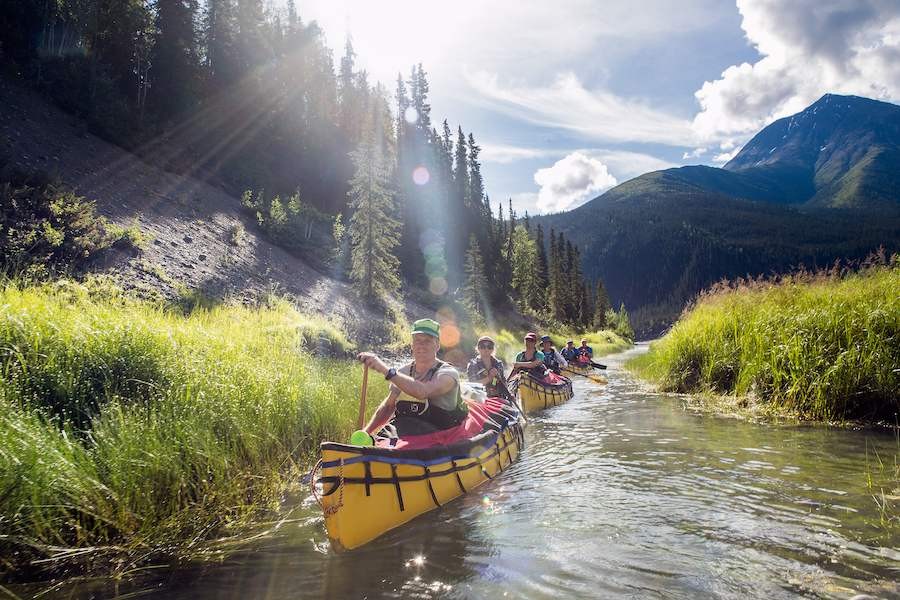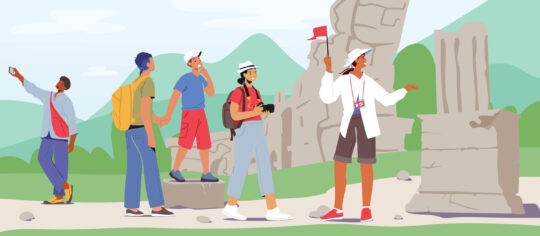Do you enjoy puzzles? Sure, they can take hours to complete, and there’s no set method to approach them, but isn’t it so satisfying to plunk in that last piece and admire your handiwork?
Designing a tour itinerary is a lot like completing a puzzle. It might take a little longer than you thought when you initially set out, and there’s no one way to design a tour. Many possible variations can get you to your destination and delight guests along the way.
Just for fun, imagine what would happen if you marketed a tour without a tour itinerary? It’s hard to picture guests feeling confident that they’d receive enough value without having an idea of what to expect.
Understandably, a tour itinerary acts as a trip plan for your guests planning a vacation and wanting to feel prepared. So, we’ll look at what you need to include in the different types of tour itineraries in tourism and how to display them in an easy-to-digest way for your prospective guests.

What is a tour itinerary?
A tour itinerary acts as a roadmap for your future guests. It tells them what they’ll be doing and seeing should they opt to book your tour. Plus, it outlines arrival time(s), frequency and duration for each tour.
Before you begin laying the groundwork for your tour, see what some of your competitors are offering. Grab a few brochures to explore details, highlights and overall tour structure.
For guests, part of the draw of booking with a tour operator is having a pre-planned itinerary. This means travellers can simply show up and enjoy the tour.
Picture yourself in a potential guest’s shoes. They’re looking at different tour options, trying to decide what activity and where to book. A detailed tour itinerary simplifies the booking experience for prospective visitors and can be a powerful marketing tactic in motivating these visitors to book your tour.
So, right in your tour introduction, describe the experience to travelers as if they were on the phone or standing in front of you. To sound approachable and lighthearted, try speaking your tour itinerary description aloud. There are many components you’ll need to factor into your itinerary and we’ll dive into those next.

Components of itinerary in tourism
Let’s say you’re evaluating whether to offer one type of tour or a range of options, try to imagine what guests will be curious about. It’s important to determine how much you can fit into your tour’s duration without pushing the timeframe.
Your guests are seeking experiences that will immerse them in the local culture and foods. As a tour guide, this is an amazing opportunity to showcase off-the-beaten-path locations and experiences designed to provide guests with an authentic experience.
In your tour description, included details that customers might ask about so they can self-screen instead of booking a tour that isn’t quite right for them. When working on drafting up an outline for your tour itinerary, make a note of what you want to lead with. For example:
- Is this tour suitable for kids?
- What type of weather can guests expect while on tour?
- Is there a certain type of experience or skill required to enjoy this tour?
- Will guests be able to take photographs on tour?
- Is a lot of walking involved on this tour?
- Do tours run frequently or are they only offered at a certain time?
A tour itinerary will look different depending on whether you offer hourly, single-day and multi-day experiences. Here are some basic steps to follow when looking at components of a tour itinerary:
1. Start by researching ideas for your tour
Deciding on what to offer is a challenge. Before you decide on your tour name and start marketing, ensure you explore a handful of ideas. You’ll want to see how seasonality affects your future plans, discover the type of equipment you’ll need. Factor in variables like weather and guest numbers before committing to a specific tour type.
2. Evaluate the competition
You might have a brilliant tour plan in mind, but is it realistic? When creating a tour from scratch it’s wise to understand your competition and whether your ideas are realistic. So while the possibilities are endless, building sustainable tour business needs to look at the competition in your area.
3. Look into partnering with vendors or attractions
When evaluating opportunities to share the workload, are there fellow experience providers that your tour business might align with?
Sure, some might look like competition at first glance, but what if there’s a way to benefit from offering experiences in the same region? Consider exploring partnerships that offer complimentary activities, meals and chances to visit unique landmarks that might save you doing some of the work.
4. Decide on the mode of transportation
As you fine-tune the plan for your tours, you’ll need to figure out how travellers will move around. Your transportation needs will be based on guest count and whether you’re planning to visit uneven terrain while sightseeing on tour.
5. Find out where to accommodate guests
One of the biggest challenges of multi-day tours is in coordinating the logistics. Accommodation, meals and transportation will all need to factor in your group size.
Since longer tours typically come with a higher price tag than hourly or single-day experiences, guests expect almost everything to be taken care of for them. Fortunately, with larger groups, you’ll be privy to lower rates for blocks of hotel rooms and the ability to book at early-bird rates.
So, while might make more sense to seek out different types of lodging, like entire homes instead of a hotel, accommodations will need to align with the type of experience you’re offering guests. If you’re offering a high-price tag tour, guests may be pretty surprised if they’re offered a more rustic experience.
6. Plan the route
Part of the fun of designing a tour is trying it out yourself to see if you’re enjoying the experience. There’s a saying I remember from 11th-grade math that runs along the lines of failing to prepare is preparing to fail. If you’re pouring energy into perfecting a tour itinerary on paper, you need to give it a dry run to see if your expectations match reality.
7. Walk it out
So, consider doing a walk-through or inviting a few friends to join for the added benefit of another perspective. This will help fine-tune the details and assist with getting the timing down. And, as you grow more familiar with your tour, you might discover better ways to approach the route or plan out points of interest.
For some National and Provincial Parks, you’ll also need to obtain a permit in advance just to visit certain sites. In Canada, you’ll want to research the Parks Canada website and here for information on permits in the USA, Based on your location, you’ll want to coordinate with your closest Tourism office.

Example of a tour itinerary description
Creating memorable experiences for your guests starts with how to market your offer. When describing a tour, you want guests to develop an emotional connection to the experience.
Let’s say you’re planning to offer a 2-hour paddleboard sunset cruise in the summer months. Your introduction could describe it as something along the lines of:
“Imagine gliding across the pacific ocean with unparalleled views of the scenic coastline, finishing with the warm glow of the sunset in a protected area of the harbour. You’ll have a whale of a good time. We hope to “seal you” you soon for our most popular 2-hour summer sunset paddle tour.”
In just a few sentences, guests can imagine themselves immersed in the experience. You’re highlighting the possibility of seeing ocean wildlife while simultaneously describing the serenity of this tour.
To further support travelers reading the full itinerary, aim to make your copy and tour descriptions easy to scan. To do so, add in plenty of bullet points, bold and photos to highlight components of the tour in a visual way.
Common tour intinerary questions
- When will the tour(s) depart and return?
- What is the frequency of your tour?
- Where will the central meeting point be?
- Is accommodation be included in the tour?
- Do you offer transportation to and from the tour?
- Will extras be available on site or for purchase?
Then, in the next section, repeat important information like meeting locations and tour frequency along with whether pricing differs depending on the time or date of booking. Are guests required to book in advance or book private tours if they book four or more spots? Address all of the questions in your tour description and make it easy for guests to find out if yours is the right type of tour for them.
3 different types of itineraries in tourism
Imagine you’re evaluating whether to offer an hourly or full, single-day tour. To deliver on a promise, explore how much you can fit into your tour’s duration without pushing the timeframe.
1. Hourly
- Hourly tours can run anywhere from 1 – 4 hours, based on what you’re going to include in the tour
- Plan for an activity that doesn’t make guests feel rushed by including enough time to put on extra gear or listen to a safety briefing pre-tour
- While on a walking tour, make a point to visit few landmarks, while also allowing guests “free time” to take photos and understand the culture
- As a bonus, you’ll be able to stay on schedule and still accommodate time for your guests to take photos
2. Single Day Tour
- A single day tour might last anywhere from 4 to 8 hours
- Curate a schedule that accounts for buffer time
- Account for ample time for guests to take photos
- Clearly describe if/when any meals are included
- Structure sightseeing for when places are less busy
- Describe meeting locations and tour frequency
3. Multi-day Tours
- Determine accommodation options for groups
- Describe the type of transportation plus pick-up/drop-off locations
- Source suppliers for meals and restaurants
- Plan out transportation to and from each new location
- Factor in a few different activities to entertain different guests
Whether you’re offering short adventures or multi-day tours, make a point to test out your tour. This will allow you to see if your timing is accurate and if you need to make any changes. As a result, you’ll be able to make adjustments that help to elevate the experience for all of your guests.

Final thoughts
Designing a tour itinerary isn’t just about fancy words and shouting from the rooftops; it’s about designing a tour that your guests want to book.
Travelers seek out activities and experiences that align with their expectations. So, if you’re hoping to create a tour itinerary that is attractive, you need to play into their interests and what you know works.
So many factors go into whether people decide to book; the images you choose, the layout of your website, your marketing tactics and the type of tour experience you offer.
Knowing this, if you can prepare travelers and exceed their expectations, you’ll have guests raving about their trips — inspiring more guests to book with you.
Want more tips like this in your inbox?

Subscribe to the Checkfront Newsletter
Read new tips on how to get more bookings every month.



